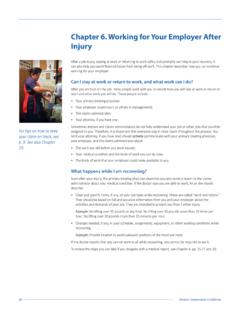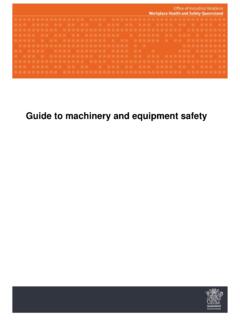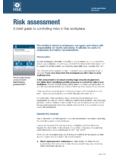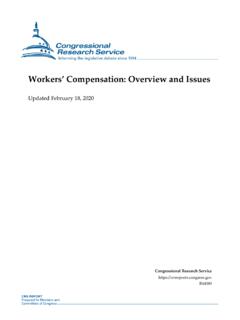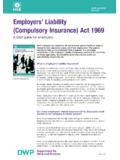Transcription of Unit 1: Health and Safety in the Engineering Workplace
1 Edexcel BTEC Level 3 Nationals specification in Engineering Issue 1 January 2010 Edexcel Limited 20091 Unit 1: Health and Safety in the Engineering WorkplaceUnit code: T/600/0249 QCF Level 3: BTEC NationalCredit value: 10 Guided learning hours: 60 Aim and purposeThis unit will give learners an understanding of the key features of Health and Safety legislation and regulations and how these are applied in Engineering to ensure safe working introductionThe welfare of people working or operating within any manufacturing or Engineering environment is of prime importance. All workers should expect to be able to carry out their work in a safe manner that has no negative effect on their Health and wellbeing. In fact, many organisations not only reduce risks and make improvements to the working environment but try to make their own working environment superior to others, making it a competitive aspect when recruiting and Safety in the Workplace is about measures designed to protect the Health and Safety of employees, visitors and the general public who may be affected by Workplace activities.
2 Safety measures are concerned with controlling and reducing risks to anyone who might be affected by these and Safety is controlled largely by legislation and regulations and the law is continually being revised and updated. It is important that organisations are aware of these changes and keep up to date with unit will give learners an understanding of hazards and risks associated with Health , Safety and welfare in an Engineering Workplace , the associated legislation and regulations and of their roles in complying with the related legal obligations. Learners will also be required to undertake full risk assessments and to appreciate the significant risks encountered in the Workplace and the measures taken to deal with them. They will also study the principles of reporting and recording accidents and incidents, again within a legal context. This unit could form a key component within many learning programmes since the content is highly applicable to many manufacturing, Engineering and industrial outcomesOn completion of this unit a learner should:1 Understand the key features of Health and Safety legislation and regulations2 Know how to identify and control hazards in the workplace3 Be able to carry out a risk assessment, identifying control measures4 Understand the methods used when reporting and recording accidents and BTEC Level 3 Nationals specification in Engineering Issue 1 January 2010 Edexcel Limited 20092 Unit content1 Understand the key features of Health and Safety legislation and regulationsKey features of legislation and regulations: legislation eg Health and Safety at Work Act 1974, Employment Act 2002, Factories Act 1961, Fire Precautions Act 1971.
3 Regulations eg Employment Equality (Age) Regulations 2006, Management of Health and Safety at Work Regulations 1999, Provision and Use of Work Equipment Regulations (PUWER) 1998, Control of Substances Hazardous to Health (COSHH) Regulations 2002, Lifting Operations and Lifting Equipment Regulations 1998, Manual Handling Operations Regulations 1992, Personal Protective Equipment at Work Regulations 1992, Confined Spaces Regulations 1997, Electricity at Work Regulations 1989, Control of Noise at Work Regulations 2005, Reporting of Injuries, Diseases and Dangerous Occurrences Regulations (RIDDOR) 1995, Working Time Regulations 1998, Workplace ( Health , Safety and Welfare) Regulations 1992, Health and Safety (First Aid) Regulations 1981, Supply of Machinery ( Safety ) (Amendment) Regulations 2005 (SI 2005/831)Roles and responsibilities of those involved: employers; employees; Health and Safety Executive (HSE) eg span of authority, right of inspection, guidance notes and booklets; others eg management, sub-contractors, public, suppliers, customers, visitors2 Know how to identify and control hazards in the workplaceWithin the Workplace : methods to identify hazards eg statements, analysis of significant risks, prediction of results or outcomes of those risks, use of accident data, careful consideration of work methodsWorking environment: consideration of the Workplace and its potential for harm eg confined spaces, working over water or at heights, electrical hazards, chemicals, noiseHazards which become risks: identification of trivial or significant risk; potential to cause harm; choosing appropriate control measures.
4 Electrical Safety eg identify and control hazards, cause of injury, effects of electricity on the body, circuit overloading; mechanical Safety eg identify and control hazards, cause of injury, rotating equipment, sharp edges; Safety devices eg residual current device (RCD), fuses, guards, fail safe, sensors3 Be able to carry out a risk assessment and identify control measuresRisk assessments: items/area to be assessed eg machine operation, work area; five steps (principal hazards, who is likely to be injured /harmed, evaluate the risks and decide on adequacy of precautions, recording findings, review assessment)Use of control measures: eg remove need (design out), use of recognised procedures, substances control, guarding, lifting assessments and manual handling assessments, regular inspection, use of Personal Protective Equipment (PPE), training of personnel, other personal procedures for Health , Safety and welfare3 Edexcel BTEC Level 3 Nationals specification in Engineering Issue 1 January 2010 Edexcel Limited 20094 Understand the methods used when reporting and recording accidents and incidentsPrinciples: why employers keep records of serious accidents, incidents and emergencies; responsibilities of competent persons; cost of accidents eg direct, indirect, human consequences.
5 Trends eg major causes, fatal and serious injury, methods of classification, statisticsRecording and reporting procedures: regulations on accident recording and reporting eg Reporting of Injuries, Diseases and Dangerous Occurrences Regulations (RIDDOR) 1995, accident book, company procedures; procedures to deal with near misses or dangerous occurrencesEdexcel BTEC Level 3 Nationals specification in Engineering Issue 1 January 2010 Edexcel Limited 20094 Assessment and grading criteriaIn order to pass this unit, the evidence that the learner presents for assessment needs to demonstrate that they can meet all the learning outcomes for the unit. The assessment criteria for a pass grade describe the level of achievement required to pass this criteriaTo achieve a pass grade the evidence must show that the learner is able to:To achieve a merit grade the evidence must show that, in addition to the pass criteria, the learner is able to:To achieve a distinction grade the evidence must show that, in addition to the pass and merit criteria, the learner is able to.
6 P1 explain the key features of relevant regulations on Health and Safety as applied to a working environment in two selected or given Engineering organisations [IE4]M1 explain the consequences of management not abiding by legislation and regulations and carrying out their roles and responsibilities in a given Health and Safety situationD1 justify the methods used to deal with hazards in accordance with Workplace policies and legal requirementsP2 describe the roles and responsibilities under current Health and Safety legislation and regulations, of those involvedM2 explain the importance of carrying out all parts of a risk assessment in a suitable mannerD2 determine the cost of an accident in the Workplace from given describe the methods used to identify hazards in a working environmentM3 explain how control measures are used to prevent describe how hazards which become risks can be controlledP5 carry out a risk assessment on a typical item/area of the working environment [SM2]
7 P6 suggest suitable control measures after a risk assessment has been carried out and state the reasons why they are suitable [CT1, EP4]P7 explain the principles that underpin reporting and recording accidents and incidentsP8 describe the procedures used to record and report accidents, dangerous occurrences or near BTEC Level 3 Nationals specification in Engineering Issue 1 January 2010 Edexcel Limited 2009 PLTS: This summary references where applicable, in the square brackets, the elements of the personal, learning and thinking skills applicable in the pass criteria. It identifies opportunities for learners to demonstrate effective application of the referenced elements of the independent enquirersCT creative thinkersRL reflective learners TW team workersSM self-managersEP effective participatorsEdexcel BTEC Level 3 Nationals specification in Engineering Issue 1 January 2010 Edexcel Limited 20096 Essential guidance for tutorsDeliveryIt is necessary to integrate Health and Safety at an early stage in all Engineering units.
8 Case studies/projects could be used for the delivery of this unit in an attempt to focus learners on the relationship between the process, the environment and Health , Safety and studies might be based on a site where the learner is working. Where this is the case, learners may need to formulate and agree the scenario and the terms of reference for the case study or project with their the unit could be taught using case studies that tutors can research from trade union material, the Health and Safety Executive (HSE) or local and national newspapers and radio stations. Indeed, the death of over 600 people every year at work is an illustration of the importance of effective education and training on Health and Safety . Many local HSEs will be very willing to give guidance and advice on accident prevention, along with statistics on Health and Safety learning outcomes form a natural order for delivery.
9 The full range of legislation and regulations can be made available, but learners could be asked to only research a given area and present their findings to the rest of the group, so that the whole group benefits from the exercise. All the areas of content are likely to be found easily on the internet. Learning outcome 2 is about knowing how to identify hazards and could be covered through practical visits to workshops, companies or other areas. Before learning outcome 3 is delivered it is appropriate to emphasise the differences between hazards and risks. The ways that risks are controlled could be dealt with in a practical way. Learners should be given opportunities to build their confidence in carrying out a risk assessment by practising this skill over a number of scenarios. This should allow them to achieve when asked to do one as an assessed activity. Photographs and drawings could be used to capture what they have done for future should be taught about the principles involved when reporting and recording accidents and near misses.
10 The pyramid of deaths to accidents to near misses should be emphasised. It is possible that research from learning outcome 1 might contain useful information regarding the requirements of RIDDOR. Visits to companies to see their procedures will strengthen learners understanding of this and all other Health , Safety and welfare that the use of eg in the content is to give an indication and illustration of the breadth and depth of the area or topic. As such, not all content that follows an eg needs to be taught or learning planThe outline learning plan has been included in this unit as guidance and can be used in conjunction with the programme of suggested outline learning plan demonstrates one way in planning the delivery and assessment of this unit. Topic and suggested assignments/activities and/assessmentWhole-class teaching:introduction to unit, scheme of work and methods of assessmentintroduction to the key features of Health and Safety legislation and regulationsexamine examples of the application and use of Health and Safety legislation and regulations in group work:work using case studies to explore relevant Health and Safety legislation and regulations within a range of industrial settings.










